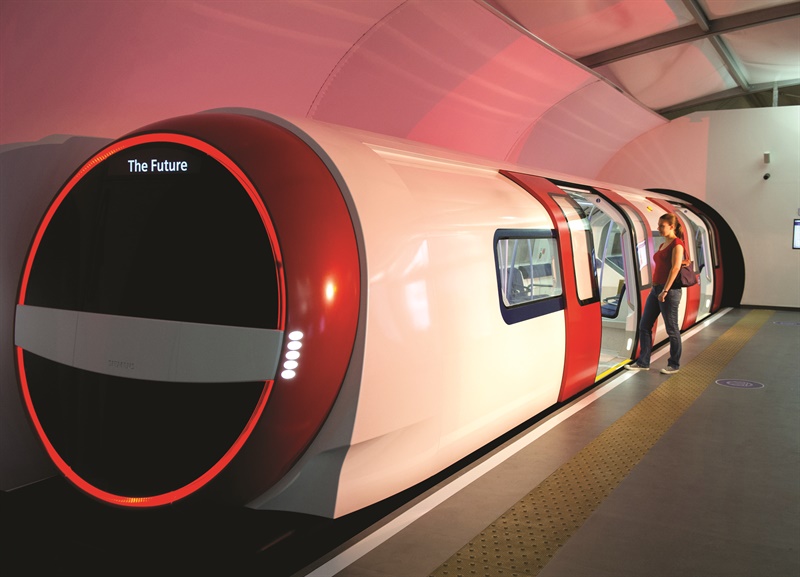28.02.14
The ‘New Tube for London’
London Underground has started the hunt to find a manufacturer for the next generation of Tube trains.
About 250 air-cooled trains are needed for the deep-level lines – Piccadilly, Central, Bakerloo and Waterloo & City.
It is placing a notice today in the Official Journal of the European Union (OJEU) seeking expressions of interest to build the new trains. A formal Invitation to Tender is expected to be issued in early 2015.
The project, once known as the Deep Tube Programme, is now called New Tube for London.
Board minutes from 5 February give an idea of the expected service frequency on the lines:
- Piccadilly line (100 trains): a 60% increase in line capacity can be achieved with new generation trains and re-signalling to enable peak services of at least 33 trains per hour (tph) by 2025;
- Central line (100 trains): a 25% increase in line capacity can be achieved with new generation trains and re-signalling to operate peak services at 33tph by 2030;
- Bakerloo line (40 trains): a 25% increase in line capacity can be achieved with new generation rolling stock and re-signalling to enable a 27tph peak service by 2033;
- Waterloo & City line (10 trains): a 50% increase in line capacity can be achieved through remodelling of the track layout at Waterloo, an increased fleet size of new generation trains and re-signalling to enable a 30tph peak service level by 2032.
It adds: “The NTfL team will specify and procure the core signalling elements of the programme. In parallel, the control and infrastructure components of civil infrastructure, track, power, cooling and associated construction elements will be developed, specified and incorporated within ITTs ready for procurement. All of this work will be developed and executed as part of an integrated railway design to ensure that all future contract requirements and interfaces can be effectively managed through delivery. A whole railway system approach will continue to be applied to ensure people, process and asset changes are fully defined and integrated.”
The benefit cost ratio is estimated at 4.2 to 1, while the cost in 2013 prices is £9.86bn, including risk at 15% and optimism bias at 25%.
TfL adds: “Prior to completion of the proposed design and specification stage in March 2016, further authority will be sought to progress the major procurements necessary, including rolling stock and signalling, for the Piccadilly line upgrade which has an estimated overall cost of £3.86bn at outturn.”
The new walk-through trains will be “capable of full automation”, TfL says.
Mayor of London Boris Johnson said: “This is a hugely important step in the continued evolution of our world-famous Tube and one that will see an iconic new fleet of trains to keep London and its economy moving.”
Mike Brown MVO, managing director of London Underground, added: “Londoners have already seen huge improvements on the Underground. The modernisation of the Victoria and Jubilee lines has delivered faster, more frequent and reliable journeys and this year we’ll also complete the upgrade of the Northern line ahead of schedule. New walk-through, air-cooled trains are already running on the Circle, Hammersmith & City and Metropolitan lines and will soon be on the District line too.
“However, we can’t stand still and must continue to invest to meet the needs of London’s rapidly growing population. Alongside modern signalling, these new trains will modernise and drastically improve capacity on the Bakerloo, Central, Piccadilly and Waterloo & City lines, allowing us to run more frequent and reliable trains, faster and closer together.
“Working with the rail industry, we want the New Tube for London to encompass the very latest technology as well as respecting our design heritage. Our new trains will be energy efficient, walk-through and provide air-cooling for the first time on the deep level lines, which are unique to London.”
One idea for the new Tube stock for the deep-level lines is Siemens’ updated Inspiro proposal, pictured above and below. Its new concept metro train went on display at The Crystal in London last year.
The most recent Tube rolling stock replacement, the S Stock on the sub-surface lines, went to Bombardier at Derby, which also built the 2009 Stock for the Victoria Line. The Northern line and Jubilee line stock were built in the mid-1990s by Alstom in Birmingham.
Tell us what you think – have your say below or email [email protected]
